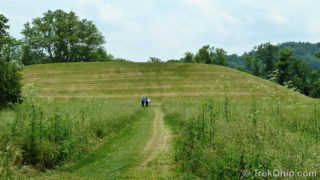 Seip Mound State Memorial Park is one of the five noncontiguous sites that make up the Hopewell Culture National Historical Park. The other four sites are Hopeton Earthworks, Hopewell Mound Group, High Banks Works, and the Mound City Group (reviewed by us here). Native Americans belonging to the Hopewell tradition constructed this mound sometime between 100 B.C. – A.D. 400.
The mound pictured above was part of a larger earthworks complex. At a number of sites in Ohio, Native Americans Read more ➜
Seip Mound State Memorial Park is one of the five noncontiguous sites that make up the Hopewell Culture National Historical Park. The other four sites are Hopeton Earthworks, Hopewell Mound Group, High Banks Works, and the Mound City Group (reviewed by us here). Native Americans belonging to the Hopewell tradition constructed this mound sometime between 100 B.C. – A.D. 400.
The mound pictured above was part of a larger earthworks complex. At a number of sites in Ohio, Native Americans Read more ➜ Hopewell Culture National Historical Park: Seip Mound
 Seip Mound State Memorial Park is one of the five noncontiguous sites that make up the Hopewell Culture National Historical Park. The other four sites are Hopeton Earthworks, Hopewell Mound Group, High Banks Works, and the Mound City Group (reviewed by us here). Native Americans belonging to the Hopewell tradition constructed this mound sometime between 100 B.C. – A.D. 400.
The mound pictured above was part of a larger earthworks complex. At a number of sites in Ohio, Native Americans Read more ➜
Seip Mound State Memorial Park is one of the five noncontiguous sites that make up the Hopewell Culture National Historical Park. The other four sites are Hopeton Earthworks, Hopewell Mound Group, High Banks Works, and the Mound City Group (reviewed by us here). Native Americans belonging to the Hopewell tradition constructed this mound sometime between 100 B.C. – A.D. 400.
The mound pictured above was part of a larger earthworks complex. At a number of sites in Ohio, Native Americans Read more ➜ 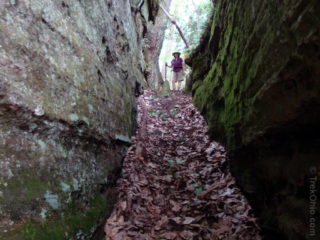 Rhododendron Cove is a spectacular place, but not the easiest preserve to find. Until quite recently, you needed a permit from the state to visit. It's open to the public now, but it's still a fairly well-kept secret. It's as though there's a secret Rhododendron Cove Club whose first rule is: don't talk about the secret Rhododendron Cove Club. I will tell you how to get there. But first let me tell you why you might want to go.
A mowed path leads from the trail with a line of trees
Rhododendron Cove is a spectacular place, but not the easiest preserve to find. Until quite recently, you needed a permit from the state to visit. It's open to the public now, but it's still a fairly well-kept secret. It's as though there's a secret Rhododendron Cove Club whose first rule is: don't talk about the secret Rhododendron Cove Club. I will tell you how to get there. But first let me tell you why you might want to go.
A mowed path leads from the trail with a line of trees 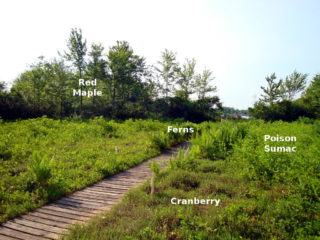 Previously I've pointed out that Jackson Bog and Cedar Bog aren't really bogs. Now it's time to look at a nature preserve that really is the bog that it claims to be: Cranberry Bog State Nature Preserve. However it's not like any other bog in the world since the entire bog is floating in the middle of a lake.
Here's what happened. For thousands of years Cranberry Bog was an ordinary bog located in what came to be known as Big Swamp. In 1830 Ohio decided to build a dyke in Big Swamp
Previously I've pointed out that Jackson Bog and Cedar Bog aren't really bogs. Now it's time to look at a nature preserve that really is the bog that it claims to be: Cranberry Bog State Nature Preserve. However it's not like any other bog in the world since the entire bog is floating in the middle of a lake.
Here's what happened. For thousands of years Cranberry Bog was an ordinary bog located in what came to be known as Big Swamp. In 1830 Ohio decided to build a dyke in Big Swamp 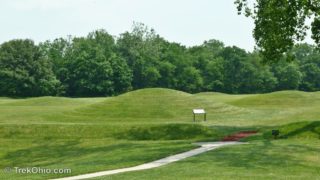 What's known as the "Mound City Group" is part of the Hopewell Culture National Historical Park in Ross County, Ohio. This land was used for funeral rituals by a Native American civilization that flourished between 200 B.C. and 500 A.D. Mound City is approximately 13 acres in size. A low earthen wall about 3 to 4 feet high (1 to 1.3 meters) lies around the perimeter; it's shape is that of a square with rounded corners. Perhaps the builders of the Mound City thought of the wall as a "sacred enclosure"
What's known as the "Mound City Group" is part of the Hopewell Culture National Historical Park in Ross County, Ohio. This land was used for funeral rituals by a Native American civilization that flourished between 200 B.C. and 500 A.D. Mound City is approximately 13 acres in size. A low earthen wall about 3 to 4 feet high (1 to 1.3 meters) lies around the perimeter; it's shape is that of a square with rounded corners. Perhaps the builders of the Mound City thought of the wall as a "sacred enclosure" 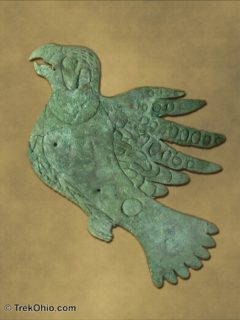 The "Hopewell Culture" refers to a Native American civilization that was centered in Ohio. It flourished here between 200 B.C. and 500 A.D. They are renowned for having built elaborate, huge, earthen structures. However when these mounds were excavated, many artifacts of great artistry were discovered. I would like to share photos of a few of these artifacts, or in some case, replicas of these artifacts. All of them were uncovered at "Mound City" which is where the Hopewell Culture National Historical
The "Hopewell Culture" refers to a Native American civilization that was centered in Ohio. It flourished here between 200 B.C. and 500 A.D. They are renowned for having built elaborate, huge, earthen structures. However when these mounds were excavated, many artifacts of great artistry were discovered. I would like to share photos of a few of these artifacts, or in some case, replicas of these artifacts. All of them were uncovered at "Mound City" which is where the Hopewell Culture National Historical 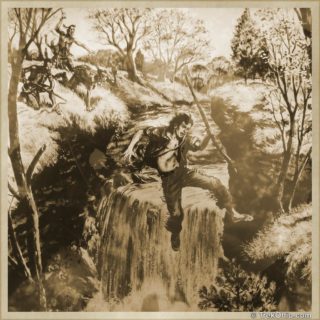 Years ago I went canoeing on the Little Miami River; the river serenely wound its way between the wooded river banks. But at Clifton Gorge, the Little Miami River is something altogether different; it plunges over falls and rapids between narrow cliffs of dolomite and shale. The river and surrounding cliffs are the main attractions of Clifton Gorge State Nature Preserve, a 268 acre preserve located adjacent to John Bryan State Park. The Little Miami River flows through both, with the nature preserve
Years ago I went canoeing on the Little Miami River; the river serenely wound its way between the wooded river banks. But at Clifton Gorge, the Little Miami River is something altogether different; it plunges over falls and rapids between narrow cliffs of dolomite and shale. The river and surrounding cliffs are the main attractions of Clifton Gorge State Nature Preserve, a 268 acre preserve located adjacent to John Bryan State Park. The Little Miami River flows through both, with the nature preserve 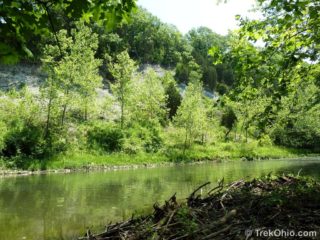 Caesar Creek Gorge State Nature Preserve is located in Oregonia, Ohio just west of Caesar Creek State Park and Caesar Creek Wilderness Area. The nature preserve is downstream from the dam located within the state park. We decided to hike the 2.25-mile trail at Caesar Creek Gorge State Nature Preserve because the preserve's official site stated that the cliff walls making up the gorge rise some 180 feet (54.9 m) above Caesar Creek. The cliffs were formed when huge volumes of torrential, meltwater
Caesar Creek Gorge State Nature Preserve is located in Oregonia, Ohio just west of Caesar Creek State Park and Caesar Creek Wilderness Area. The nature preserve is downstream from the dam located within the state park. We decided to hike the 2.25-mile trail at Caesar Creek Gorge State Nature Preserve because the preserve's official site stated that the cliff walls making up the gorge rise some 180 feet (54.9 m) above Caesar Creek. The cliffs were formed when huge volumes of torrential, meltwater 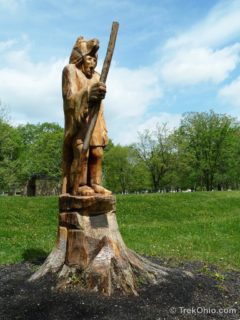 Overview
The Newark Earthworks were constructed about 2000 years ago by the prehistoric, Hopewell people. These are the largest, geometric earthworks in the world. To give you a better sense of the size and shape of these structures, it's best to look at an aerial view. Since I can't take aerial photos myself, I photographed some of the interpretive signs near the earthworks.
The plaque below shows the layout of the Newark Earthworks which occupy four square miles (10.6 square kilometers).
I
Overview
The Newark Earthworks were constructed about 2000 years ago by the prehistoric, Hopewell people. These are the largest, geometric earthworks in the world. To give you a better sense of the size and shape of these structures, it's best to look at an aerial view. Since I can't take aerial photos myself, I photographed some of the interpretive signs near the earthworks.
The plaque below shows the layout of the Newark Earthworks which occupy four square miles (10.6 square kilometers).
I  The glacial grooves on Kelley's Island are a designated National Natural Landmark. They were formed during the last Ice Age about 18,000 years ago, and they are the world's largest, known glacial striations. Typically glacial striations are formed when boulders and gravel are dragged across the bedrock under the immense weight of a glacier. Geologists rely on these natural features to determine the direction in which the now-melted ice once flowed. However according to the Ohio Department of Natural
The glacial grooves on Kelley's Island are a designated National Natural Landmark. They were formed during the last Ice Age about 18,000 years ago, and they are the world's largest, known glacial striations. Typically glacial striations are formed when boulders and gravel are dragged across the bedrock under the immense weight of a glacier. Geologists rely on these natural features to determine the direction in which the now-melted ice once flowed. However according to the Ohio Department of Natural  Quite a few of the parks where I hike have structures or other vestiges of days gone by. During our hike to Clear Creek Metro Park, there was a log cabin and a barn made of hand-hewn timber. For a while I had been thinking, "Wouldn't it be fun to take my photos of these structures, and give them a vintage look?" So here is my first effort at doing just that.
I followed the instructions I found in this YouTube video to do the above photo-editing. The instructor in the video
Quite a few of the parks where I hike have structures or other vestiges of days gone by. During our hike to Clear Creek Metro Park, there was a log cabin and a barn made of hand-hewn timber. For a while I had been thinking, "Wouldn't it be fun to take my photos of these structures, and give them a vintage look?" So here is my first effort at doing just that.
I followed the instructions I found in this YouTube video to do the above photo-editing. The instructor in the video